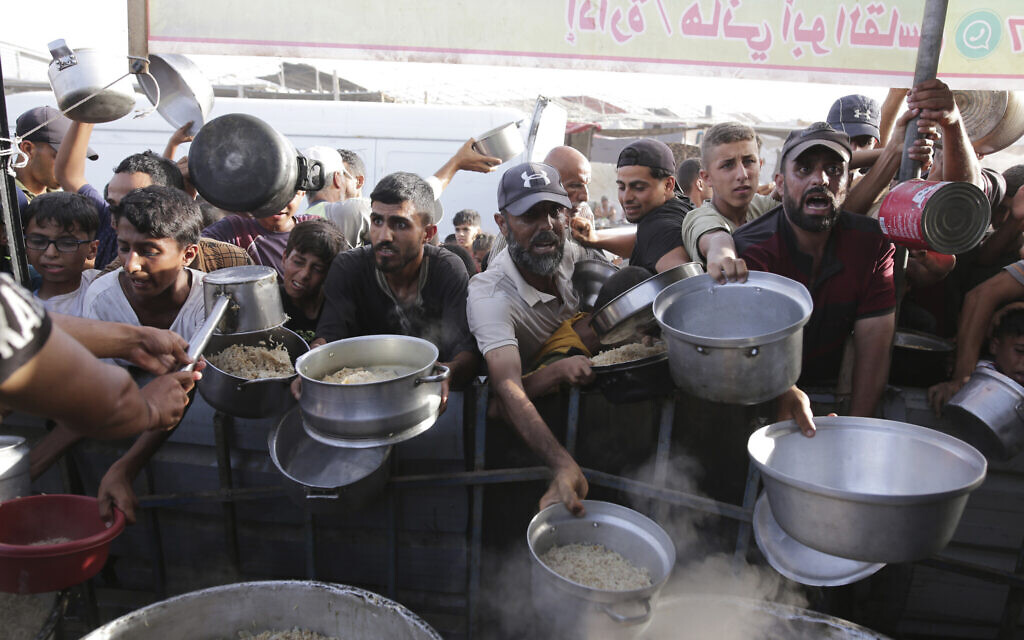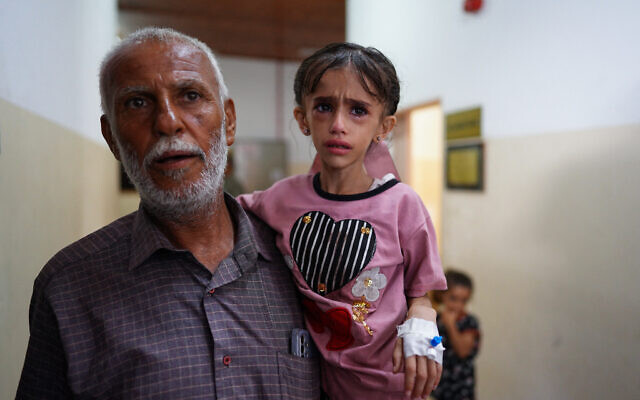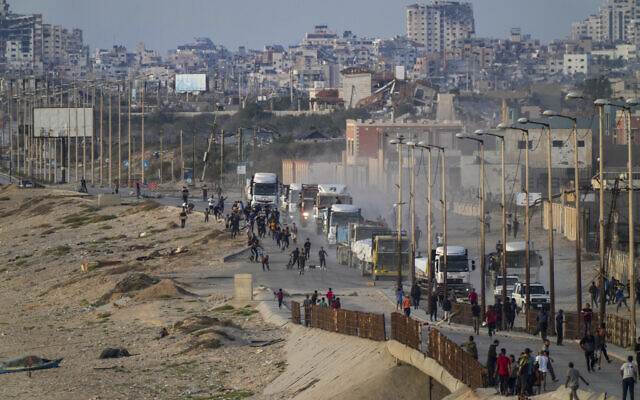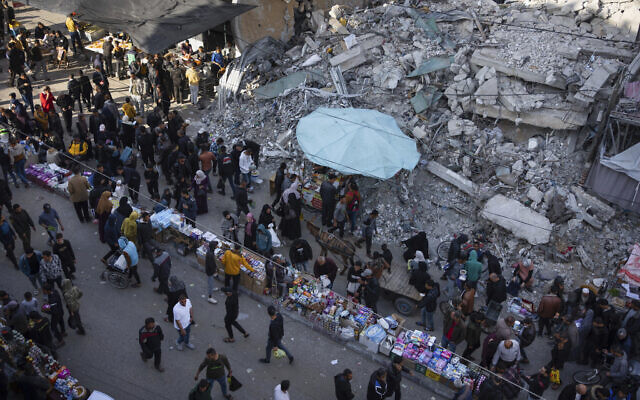New Gaza famine report reveals grim March predictions were vastly exaggerated
Study appears to emphasize outlying malnutrition results, does not disclose mortality data, leading some experts to question the basis of its new projections

A report released last week by the Integrated Food Security Phase Classification (IPC) organization, which found that there is not currently a famine in Gaza, has confirmed doubts that were raised earlier this year about claims of mass starvation, due to the absence of evidence.
A close examination of the report reveals discrepancies not only between what has been claimed by UN agencies and humanitarian officials about the situation in Gaza, but between the rhetorical assertions of the IPC itself and the data in its own report.
The data also demonstrates that the IPC’s projection in March that some 1.1 million Gazans would be suffering from the highest level of food insecurity possible by some time in July was wildly wrong according to its new study: It was more than three times higher than the actual number of people in that category as of June 15.
These deficiencies have led some experts to question the basis of the IPC’s new projections, which again predict an increase in famine in the Gaza Strip.
Prof. Aron Troen of Hebrew University’s School of Nutrition Science said that the “limited transparency” of the study and the “slanted projections” included in it were undermining “faith in the report and in the neutrality and impartiality” of the IPC and its institutions.
The IPC did not respond to a request for comment by The Times of Israel, and has refused multiple requests for interviews and information over the last two months.

The IPC, connected to the UN’s Food and Agriculture Organization, is viewed as a neutral and authoritative agency whose purpose is to warn of and draw attention to famines and looming famines around the world.
Its March report predicting that there would be famine in Gaza sometime before July 15 set off alarm bells around the world of an impending humanitarian disaster.
The allegations of approaching famine have also formed a central part of the legal processes against Israel’s conduct of the war against Hamas in both the International Court of Justice and the International Criminal Court in the Hague, the latter of which has accused Prime Minister Benjamin Netanyahu and Defense Minister Yoav Gallant of war crimes and crimes against humanity for allegedly using starvation as a method war against the Palestinians.
Amid these allegations, the provision of humanitarian aid to Gaza has become a key concern, with UN agencies and some aid groups criticizing Israel for not allowing enough aid in and not doing enough to facilitate its transfer to the Gazan population.
Israel has persistently claimed, however, that it has facilitated the transfer of tens of thousands of aid trucks with enough food to provide for Gaza’s nutritional needs, and has blamed the UN for not scaling up its logistics and distribution operations.
According to the IPC, a famine can be determined when three conditions are met: 20 percent of households face an extreme lack of food, 30% of children are suffering from acute malnutrition, and there are at least two adult deaths or four child deaths per 10,000 people, per day, from starvation.
The latest IPC report issued last Tuesday fulfills none of these criteria.
According to the IPC’s latest study, 5% of the Gazan population is currently in what it defines as “Phase 2 – Stressed” on its food insecurity scale, while another 51% are defined as in “Phase 3 – Crisis.”
Another 29% are classified as in “Phase 4 – Emergency” while 15% are said to be at “Phase 5 – Catastrophe,” the highest designation there is.
But despite the fact that 55% of the population is defined as being in Phase 3 or better, the IPC’s latest report determined the entire Gaza Strip to be at the “Phase 4 – Emergency” level of food insecurity.

The organization also projected that between June 16 and September 30, the percentage of the population suffering from Phase 5 food insecurity would rise to 22% and those at Phase 4 would rise to 33%.
But the IPC’s previous projections were wildly inaccurate.
In its March report, the IPC projected that fully 50% of the population would be at the “Phase 5 – Catastrophe” level at some stage before July 15, but the actual figure as of June 15 was 15%.
In effect, the IPC projection was off by some 233%; in human terms it missed the mark by some 777,000 people.
Similarly, the March report projected that 38% of the Gazan population would be in Phase 4 at some stage before July 15, compared to what it found to be 29% as of June 15, a prediction that was off by some 31%.
The IPC report also appeared to downplay positive trends in the food security situation.
The only physical indicator of malnutrition available to the IPC for use in its reports has been a measurement called Middle Upper Arm Circumference (MUAC) screenings, typically performed on children aged 6-59 months.
In its March report, the IPC found a MUAC prevalence of 12.4% to 16.5% for the northern governorates of Gaza, which was where the risk of famine was thought to be highest. This represented a steep increase over earlier results.

MUAC prevalence above 15% indicates that a territory has entered Phase 4 or 5 of the IPC’s food insecurity scale.
But in its new report it found that the MUAC scores had declined even more steeply in northern Gaza to just 1%, or the same as prewar levels.
Despite this sharp drop-off in malnutrition prevalence by MUAC results, the new IPC report nevertheless opined that “the rapid changes in prevalence of acute malnutrition” meant that future deteriorating conditions “might result” in worsening malnutrition.
But such an evaluation is “entirely hypothetical” said Troen, the Hebrew University expert. He also pointed out other issues with the IPC’s interpretation of its own data.
In the Rafah governorate in southern Gaza, the IPC reported that MUAC screening results ranged from 1% to 12% but with a median of 2.6%, and in Khan Younis in the south and Deir al-Balah in central Gaza screenings ranged from 1% to 10%, although no median value was given.
The report said that this meant that there was an upward trend in the prevalence of malnutrition in these governorates, but Troen noted that the high prevalence results were outliers among the overall data collected, and that the average was much lower.
The new study also did not provide data from earlier months to demonstrate that that there had been an upward trend. The IPC’s March report also lacked MUAC screening results for these governorates.
The presentation of mortality from starvation data, or the lack thereof, was also obfuscated by the IPC to a certain extent.
The report cited results of a telephone survey conducted by a Palestinian polling company on behalf of the World Food Program from April 20 to June 9 of 1,104 households with a combined total of 5,707 individuals, in which 42 deaths were reported from all causes, including violent deaths from injuries sustained during the war.
This gave a Crude Death Rate off 0.55 deaths per 10,000 people, per day, from all causes.
“Exclusion of deaths caused by violence resulted in lower estimated death rates,” the report said, without actually giving the number of violent deaths recorded in the WFP study.
According to the IPC’s criteria, in order to determine that a famine is occurring there must be at least two adult deaths or four child deaths per 10,000 people, per day, from starvation alone.
“Given that only 42 deaths were recorded, it is safe to assume that the nonviolent death rate was close to nil,” said Troen.
The World Food Program has not publicly published the results of the survey cited by the IPC, and the IPC itself did not make the data available in its report, so ascertaining the actual number and rate of deaths from starvation is currently impossible.
“The purpose of the IPC is to sound an alarm to spur action before it is too late. To some extent they have done this, at the expense of accuracy and caution,” said Troen.
“There is no question that there is severe suffering in Gaza and no room for complacency,” he continued, adding that a joint effort by Israelis, international agencies, and Palestinians was needed to ensure an effective humanitarian response.
“Unfortunately, it seems that the limited transparency and slanted projections authored by the IPC are having the opposite effect. Positing extreme worst-case scenario projections as the most likely outcome undermines faith in the report and in the neutrality and impartiality of the institutions and partner organizations that make up the IPC to provide the data and produce the report, it impedes cooperation between the parties and motivates fixing the blame instead of the problem, and plays into the hands of the extremists who cynically, cruelly and strategically exploit human suffering to advance their nefarious aims.”
No comments:
Post a Comment